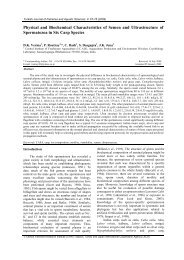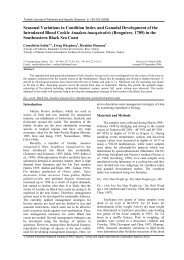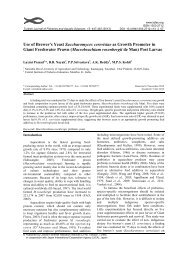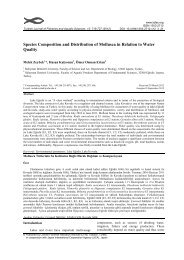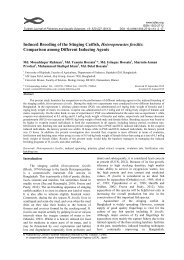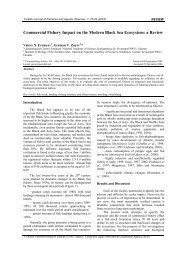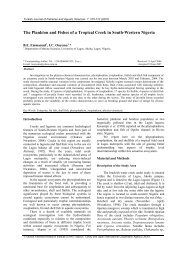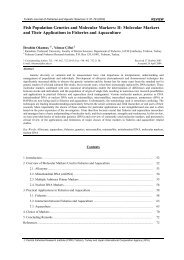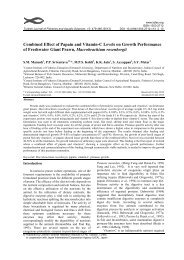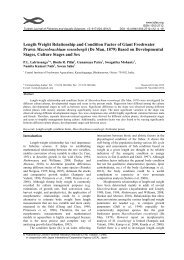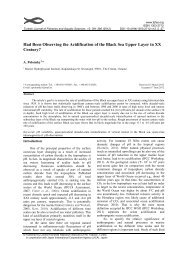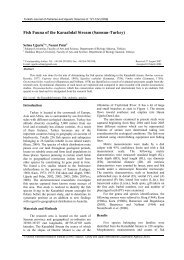Feeding Habits of Black Scorpionfish Scorpaena porcus, in the ...
Feeding Habits of Black Scorpionfish Scorpaena porcus, in the ...
Feeding Habits of Black Scorpionfish Scorpaena porcus, in the ...
You also want an ePaper? Increase the reach of your titles
YUMPU automatically turns print PDFs into web optimized ePapers that Google loves.
Turkish Journal <strong>of</strong> Fisheries and Aquatic Sciences 9: 99-103 (2009)<strong>Feed<strong>in</strong>g</strong> <strong>Habits</strong> <strong>of</strong> <strong>Black</strong> <strong>Scorpionfish</strong> <strong>Scorpaena</strong> <strong>porcus</strong>, <strong>in</strong> <strong>the</strong> South-Eastern <strong>Black</strong> SeaNimet Selda Başçınar 1, *, Hacer Sağlam 11 Central Fisheries Research Institute, 61250, Kaşüstü, Trabzon, Turkey.* Correspond<strong>in</strong>g Author: Tel.: +90.462 3411053; Fax: +90.462 3411152;E-mail: seldabasc<strong>in</strong>ar@yahoo.comAbstractReceived 23 September 2008Accepted 15 January 2009This study was carried out to describe <strong>the</strong> feed<strong>in</strong>g habits <strong>of</strong> <strong>Scorpaena</strong> <strong>porcus</strong> and to <strong>in</strong>vestigate <strong>the</strong> effect <strong>of</strong> sex, sizeand season on <strong>the</strong>ir diet. With<strong>in</strong> <strong>the</strong> framework <strong>of</strong> this study, food preferences <strong>of</strong> 262 <strong>Scorpaena</strong> <strong>porcus</strong> (13±0.26 cm;67±3.46 g) (±SE <strong>of</strong> means) which were taken from <strong>the</strong> stomach contents <strong>of</strong> fish caught at Trabzon coast (located at <strong>the</strong> South– Eastern <strong>Black</strong> Sea coast, between November 2003 and January 2004) were <strong>in</strong>vestigated. <strong>Scorpaena</strong> <strong>porcus</strong> fed ma<strong>in</strong>ly uponred mullet (Mullus barbatus) (IRI%=34.67) and mud shrimp (Upogebia pusilla) (IRI%=28.10), but also upon harbour crab,brown shrimp, sea horse, and o<strong>the</strong>rs. It was found that <strong>the</strong>re were significant differences between its dietary habits <strong>in</strong> summerand w<strong>in</strong>ter times (χ 2 =38.10, P
100 N.S. Başçınar and H. Sağlam / Turk. J. Fish. Aquat. Sci. 9: 99-103 (2009)Material and Methods<strong>Scorpaena</strong> <strong>porcus</strong> were collected <strong>in</strong> November2003 and February 2004 by us<strong>in</strong>g bottom trawls atTrabzon coast (South – Eastern <strong>Black</strong> Sea). <strong>Black</strong>scorpionfish were caught at depths (sandy bottom)rang<strong>in</strong>g from 20 to 40 m. at 10:00-11:00 a.m. everymonth. Temperature <strong>of</strong> depths where samples werecollected was recorded us<strong>in</strong>g CTD System(conductivity- temperature-depth). Temperature wasfound 9.0-15.4°C (summer), 8.7-8.8°C (w<strong>in</strong>ter). Thefish samples were taken to <strong>the</strong> laboratory for stomachanalysis. Total length (nearest 1mm) and fresh weight(nearest 0.001 g) <strong>of</strong> <strong>the</strong> <strong>in</strong>dividual sampled specimenswere measured and <strong>the</strong>ir sex (only summer) weredeterm<strong>in</strong>ed. Stomachs were fixed <strong>in</strong> formal<strong>in</strong> <strong>in</strong>plastic jars for subsequent analysis. Next, fish weregutted and cut open. Prey items <strong>in</strong> <strong>the</strong> stomachs wereidentified down to <strong>the</strong> most precise taxonomic level.The total number, wet weight and frequency <strong>of</strong>occurrence <strong>of</strong> each prey item <strong>in</strong> <strong>the</strong> stomach <strong>of</strong> <strong>the</strong>fish were recorded.The percentage <strong>of</strong> empty stomach (vacuity<strong>in</strong>dex, V%) and stomach content weight were used toevaluate <strong>the</strong> feed<strong>in</strong>g activity <strong>of</strong> fish. For diet analysis,<strong>the</strong> percentages <strong>of</strong> frequency <strong>of</strong> occurrence (O%),number (N%) and weight (W%) for each prey typewere used to describe <strong>the</strong> diet <strong>of</strong> this species (Hyslop,1980). The <strong>in</strong>dex <strong>of</strong> relative importance[IRI i = (N %+ W %)* O%] and <strong>the</strong>IRI% (IRI i % = 100* IRI i /∑IRIi)ni=1were calculated for each prey category and used<strong>in</strong> diet comparisons (P<strong>in</strong>kas et al., 1971; Cortes, 1997;Morato et al., 2003).To asses changes <strong>in</strong> diet with size, blackscorpionfish were divided <strong>in</strong>to three size classes (6-12(n= 143), 12-18 (n=101), 18-24 (n= 18) cm). The diet<strong>of</strong> black scorpionfish was also analyzed by sex andseason.Statistical differences <strong>in</strong> diet composition <strong>in</strong>relation to size, season and sex were assessed us<strong>in</strong>g χ 2- test (Sokal and Rohlf, 1981). This was applied over<strong>the</strong> number <strong>of</strong> stomachs <strong>in</strong> which a prey occurs.Different prey items were pooled <strong>in</strong>to six categoriesus<strong>in</strong>g cont<strong>in</strong>gency tables. These categories were: Redmullet, sea horse, mud shrimp, brown shrimp, harbourcrab and o<strong>the</strong>rs (Bittium reticulatum, hermit crab,shrimp larvae, algae and tissue unidentified). Allgraphs were developed by us<strong>in</strong>g Micros<strong>of</strong>t Excel 7.0 ®s<strong>of</strong>tware.ResultsGeneral diet CompositionOut <strong>of</strong> 262 stomachs <strong>of</strong> S. <strong>porcus</strong>, mean length13±0.26 cm (±SE <strong>of</strong> means) (range 6.3-23.5 cm) andmean weight 67±3.46 g (range 5.6-257.2 g) exam<strong>in</strong>ed,86 were found to be empty (V% = 32.83). Ten preyspecies (two fish, six crustaceans, one mollusc andone algae) were identified <strong>in</strong> <strong>the</strong> stomach <strong>of</strong> S. pocus.The red mullet (Mullus barbatus [IRI%=34.67])was found as <strong>the</strong> ma<strong>in</strong> diet component <strong>of</strong> blackscorpionfish and <strong>the</strong> mud shrimp, Upogebia pusilla[IRI%= 28.10] was identified as <strong>the</strong> most importantcrustacean decapod prey item. O<strong>the</strong>r importantcrustaceans <strong>in</strong>cluded harbour crab, Liocarc<strong>in</strong>usdepurator [IRI%=27.32] and brown shrimp (Crangoncrangon [IRI%=3.17]), seahorse Hippocampus sp.[IRI%=5.02] and o<strong>the</strong>rs (Ulva lactuca, Shrimp larvae,Isopoda, Hermit crab, Bittium reticulatum and tissuesunidentified [IRI%=1.72]) (Table 1).Size-related Changes <strong>in</strong> <strong>the</strong> DietThe diet <strong>of</strong> <strong>the</strong> small black scorpionfish (6-12cm) was composed ma<strong>in</strong>ly <strong>of</strong> <strong>the</strong> red mullet, Mullusbarbatus [IRI%=62.24]. Also for medium size blackscorpionfish, (12-18 cm) <strong>the</strong> red mullet, Mullusbarbatus [IRI%=16.76] was <strong>the</strong> dom<strong>in</strong>ant species.However, for <strong>the</strong> larger size black scorpionfish (18-24cm size calss), sea horse, Hippocampus sp. [IRI%=32.18] was found as <strong>the</strong> ma<strong>in</strong> prey species (Table 2).A chi-square test based on <strong>the</strong> relationshipbetween <strong>the</strong> size classes <strong>of</strong> scorpionfish and <strong>the</strong>change <strong>in</strong> <strong>the</strong> stomach contents, revealed significantdifferences among black scorpionfish size classes(χ 2 = 42.96 P
N.S. Başçınar and H. Sağlam / Turk. J. Fish. Aquat. Sci. 9: 99-103 (2009) 101Table 2. Ma<strong>in</strong> prey categories (IRI%) for S. <strong>porcus</strong> size classes (N: number <strong>of</strong> prey, n=number <strong>of</strong> fish)Prey N 6-12 cm N 12-18 cm N 18-24 cm χ 2 P(n=143)(n=101)(n=18)Mullus barbatus ponticus 36 62.24 21 16.76 7 15.42 31.06 P
102 N.S. Başçınar and H. Sağlam / Turk. J. Fish. Aquat. Sci. 9: 99-103 (2009)% N% W403530252015105050454035302520151050summerw<strong>in</strong>ter% O% IRI454035302520151050706050403020100red mullet mud shrimp brown shrimp harbour crab sea horse o<strong>the</strong>rsFigure 1. N%, W%, O%, IRI% <strong>of</strong> <strong>the</strong> ma<strong>in</strong> prey catogories for S. Porcus.Table 3. Ma<strong>in</strong> prey categories (IRI%) for S. <strong>porcus</strong> size classes, general, <strong>in</strong> summer and w<strong>in</strong>ter and female (F), male (M) <strong>in</strong>summerLength (cm)Prey6-12 12-18 18-24 Season Sex (summer)summer w<strong>in</strong>ter summer w<strong>in</strong>ter summer w<strong>in</strong>ter summer w<strong>in</strong>ter F MRed mullet 3.59 71.41 2.46 41.34 21.06 3.25 10.41 57.46 7.04 4.12Mud shrimp 10.35 10.17 58.53 6.92 13.55 27.36 0.00 13.11 57.65 33.06Brown shrimp 2.38 1.24 19.95 0 0 0 19.94 0.49 2.75 26.00Harbour crab 82.23 16.62 14.08 22.34 65.39 5.34 63.43 20.01 29.72 32.31Sea horse 0 0 0.45 29.00 0 63.17 0.45 8.21 0 1.36O<strong>the</strong>rs* 1.45 0.56 4.53 0.40 0 0.88 5.77 0.72 2.84 3.15Stomachs (n) 143 101 18 262 35 47* (Ulva lactuca, Shrimp larvae, Isopoda, Hermit crab, Bittium reticulatum and tissues unidentified)changed depend<strong>in</strong>g on size classes. The small andlarge sized black scorpionfish <strong>in</strong> this study fed ma<strong>in</strong>lyon harbour crab whereas <strong>the</strong> medium size blackscorpionfish fed ma<strong>in</strong>ly on mud shrimp <strong>in</strong> summer. Ithas been found that <strong>in</strong> w<strong>in</strong>ter both small and mediumsize black scorpionfish fed ma<strong>in</strong>ly on red mullet while<strong>the</strong> larger size ones fed upon sea horse. Similar resultswere reported by o<strong>the</strong>r studies (Harmel<strong>in</strong>-Vivien etal., 1989; Bradai and Boua<strong>in</strong>, 1990; Arculeo et al.,1993; Morte et al., 2001). This change was due to <strong>the</strong>decrease <strong>of</strong> frequency <strong>of</strong> occurrence <strong>of</strong> amphipodsand o<strong>the</strong>r crustaceans with <strong>in</strong>creas<strong>in</strong>g predator size,whereas <strong>the</strong> frequency <strong>of</strong> occurrence <strong>of</strong> reptantia,brachyra and o<strong>the</strong>r group <strong>in</strong>creased. A positivecorrelation between <strong>the</strong> <strong>in</strong>dividual size <strong>of</strong> predatorand <strong>of</strong> prey <strong>in</strong>gested has been frequently observed <strong>in</strong>different species <strong>of</strong> scorpaenids. Scorpean. <strong>porcus</strong>and <strong>Scorpaena</strong> notata, amphipods and isopods were
N.S. Başçınar and H. Sağlam / Turk. J. Fish. Aquat. Sci. 9: 99-103 (2009) 103almost exclusively consumed by <strong>the</strong> small sized fish,whereas decapods (brachyuran and carids) were <strong>the</strong>most abundant prey <strong>of</strong> larger <strong>in</strong>dividuals (Harmel<strong>in</strong>-Vivien et al., 1989; Bradai and Boua<strong>in</strong>, 1990; Arculeoet al., 1993; Morte et al., 2001).<strong>Feed<strong>in</strong>g</strong> habit <strong>of</strong> <strong>Scorpaena</strong> <strong>porcus</strong> changedseasonally <strong>in</strong> this research. It was found that <strong>the</strong> blackscorpionfish fed on harbour crab most frequently <strong>in</strong>summer and on red mullet <strong>in</strong> w<strong>in</strong>ter. The ma<strong>in</strong> dietcomponents <strong>of</strong> black scorpionfish (both sexes) <strong>in</strong>summer were mud shrimp and harbour crab.However, females’ preference was mostly mudshrimp and male preference was mud shrimp.Seasonal variation <strong>of</strong> <strong>the</strong> diet seems to be associatedwith <strong>the</strong> availability <strong>of</strong> <strong>the</strong> prey, whose distributionand abundance are related to <strong>the</strong> dynamics <strong>of</strong> <strong>the</strong>water masses <strong>of</strong> region (Muto et al., 2001). In o<strong>the</strong>rscorpaenids, <strong>the</strong> feed<strong>in</strong>g <strong>in</strong>tensity followed roughly aseasonal trend (La Mesa et al., 2007). Several studiesrevealed that <strong>the</strong> highest percentage <strong>of</strong> emptystomachs occurs dur<strong>in</strong>g reproduction, ow<strong>in</strong>g to asignificant decrease <strong>in</strong> food <strong>in</strong>take <strong>in</strong> such a period forscorpaenids (Morte et al., 2001). Similar result werefound <strong>in</strong> this study. Stomachs <strong>of</strong> S. <strong>porcus</strong> were foundto be empty (V% = 28.33) <strong>in</strong> summer samples.In <strong>the</strong> end <strong>of</strong> <strong>the</strong> study, it was found that <strong>the</strong>feed<strong>in</strong>g habits changed seasonally accord<strong>in</strong>g to twovariables, namely, fish size and sex. This research isimportant for fur<strong>the</strong>r studies as to create a referencepo<strong>in</strong>t to make any possible comparison.The study <strong>of</strong> natural diets <strong>of</strong> fish species is veryuseful approach for understand<strong>in</strong>g aspect <strong>of</strong> <strong>the</strong>species biology and ecology, towards a moresusta<strong>in</strong>able management <strong>of</strong> <strong>the</strong>ir stocks and <strong>the</strong>development <strong>of</strong> conservation measures (La Mesa etal., 2007; Kitsos et al., 2008).AcknowledgementsThanks to capta<strong>in</strong>s D. Selim Mısır and Hüsey<strong>in</strong>Selen for help<strong>in</strong>g <strong>the</strong> collection <strong>of</strong> specimens.ReferencesArculeo, M., Froglia, C. and Riggio, S. 1993. Foodpartition<strong>in</strong>g between Serranus scriba and <strong>Scorpaena</strong><strong>porcus</strong> (Perciformes) on <strong>the</strong> <strong>in</strong>fralittoral ground <strong>of</strong> <strong>the</strong>South Tyrrhenian Sea. Cybium., 17: 251–258.Bachok, Z., Mansor, M.I. and Noord<strong>in</strong>, R.M. 2004. Dietcomposition and feed<strong>in</strong>g habits <strong>of</strong> demersal andpelagic mar<strong>in</strong>e fishes from Terengganu waters, eastcoast <strong>of</strong> pen<strong>in</strong>sular Malaysia. NAGA. WorldfishCenter Quarterly, Malaysia, 27(3–4).Bradai, M.N. and Boua<strong>in</strong>, A. 1990. <strong>Feed<strong>in</strong>g</strong> pattern <strong>of</strong><strong>Scorpaena</strong> <strong>porcus</strong> and S. scr<strong>of</strong>a (Teleostei,Scorpaenidae) from Gulf <strong>of</strong> Gabes, Tunisia. Cybium,14: 207–216.Bulgakova, T., Vasilyev, D. and Daan, N. 2001. Weight<strong>in</strong>gand smooth<strong>in</strong>g <strong>of</strong> stomach content data as <strong>in</strong>put forMSVPA with particular reference to <strong>the</strong> Barent Sea.ICES Journal <strong>of</strong> Mar<strong>in</strong>e Science, 58: 1208-1218.Christensen, S. and Pauly, D. 1992. ECOPATH II- as<strong>of</strong>tware for balanc<strong>in</strong>g steady-state ecosystem modelsand calculat<strong>in</strong>g network characteristics. EcologicalModell<strong>in</strong>g, 61: 169-185.Cortes, E. 1997. A Critical review <strong>of</strong> methods <strong>of</strong> study<strong>in</strong>gfish feed<strong>in</strong>g based on analysis <strong>of</strong> stomach contents:application to elasmobranch fishes. Canadian JournalFish Aquat. Sci., 54: 726-738.Harmel<strong>in</strong>-Vivien, M.L., Kaim-Malka, R.A., Ledoyer, M.and Jacob-Abraham, S.S. 1989. Food partition<strong>in</strong>gamong scorpaenid fishes <strong>in</strong> Mediterranean seagrassbeds. Journal <strong>of</strong> Fish Biology, 34: 715-734.Hureau, J.C. and Litu<strong>in</strong>enko, N.J. 1986. Fishes <strong>of</strong> <strong>the</strong> North-Eastern Atlantic and <strong>the</strong> Mediterranean, In: P.J.P.Whitehead, M.L. Bauchot, J.C. Hureu, J. Nielsoen andE. Tortonese (Eds), Scorpaenidae. UNESCO, Paris, 3:1211-1229.Hyslop, E.J. 1980. Stomach contents analysis a review <strong>of</strong>methods and <strong>the</strong>ir application. Journal <strong>of</strong> FishBiology, 17: 411-429.İbrahim, S., Muhammad, M., Ambak, M.A., Zakaria, M.Z.,Mamat. A.S., İsa, M.M. and Hajısamae, S. 2003.Stomach Contents <strong>of</strong> Six Commercially ImportantDemersal Fishes <strong>in</strong> <strong>the</strong> South Ch<strong>in</strong>a Sea, TurkishJournal <strong>of</strong> Fisheries and Aquatic Science, 3: 11-16.Kitsos, M.S., Tzomos, T.H., Anagnostopoulou, L. andKoukouras, A. 2008. Diet composition <strong>of</strong> seahorses,Hippocampus guttulatus Cuvier, 1829 andHippocampus hippocampus (L., 1758) (Teleostei,syngathidae) <strong>in</strong> <strong>the</strong> Aegean Sea. Journal <strong>of</strong> FishBiology, 72: 1259-1267.La Mesa, G., La Mesa, M. and Tomassetti, P. 2007. <strong>Feed<strong>in</strong>g</strong>habits <strong>of</strong> <strong>the</strong> Madeira rockfish, <strong>Scorpaena</strong>maderensis, from central Mediterranean Sea. MarieBiology, 150: 1313–1320.Lopez-Peralta, R.H. and Arcila, C.A.T. 2002. Dietcomposition <strong>of</strong> fish species from <strong>the</strong> sou<strong>the</strong>rncont<strong>in</strong>ental shelf <strong>of</strong> Colombia. Naga, WorldFishCenter Quarterly, 25(3-4): 23-29.Morato, T., Solà, E., Gros, M.P. and Menezes, G. 2003.Diets <strong>of</strong> Thornback Ray (Raja clavata) and TopeShark (Galeorh<strong>in</strong>us galeus) <strong>in</strong> <strong>the</strong> Bottom Longl<strong>in</strong>eFishery <strong>of</strong> <strong>the</strong> Azores, Nor<strong>the</strong>astern Atlantic, Fish.Bull., 101: 590-602.Morte, S., Redon, M.J. and Sanz-Brau, A. 2001. Diet <strong>of</strong><strong>Scorpaena</strong> <strong>porcus</strong> and <strong>Scorpaena</strong> notata (Pisces:Scorpaenidae) <strong>in</strong> The Western Mediterranean. Cahiersde Biologie Mar<strong>in</strong>e, 42(4): 333-344.Muto, E.Y., Soares, L.S.H. and Goite<strong>in</strong>, R. 2001. FoodResource utilization <strong>of</strong> <strong>the</strong> skates Rioraja agassizii(Müller and Henle, 1841) and Psammobatis extenta(German, 1913) on <strong>the</strong> Cont<strong>in</strong>ental shelf <strong>of</strong>f Ubatuba,South-eastern Brazil. Rev. Brasileira de Biplogia, 61:217-238.Pallaoro, A. and Jardas, I. 1991. Food and <strong>Feed<strong>in</strong>g</strong> <strong>Habits</strong><strong>of</strong> <strong>Black</strong> <strong>Scorpionfish</strong> (<strong>Scorpaena</strong> <strong>porcus</strong> L. 1758)(Pisces, Scorpaenıdae) Along The Adriatic Coast.,Acta Adriatica, 32(2): 885-898.P<strong>in</strong>kas, L.M., Oliphant. S. and Iverson. I.L.K. 1971.<strong>Feed<strong>in</strong>g</strong> habits <strong>of</strong> albacore. Bluef<strong>in</strong> tuna and bonito <strong>in</strong>Californian waters. Calif. Fish Game, 152: 1-105.Sokal, R.R. and Rohlf, F.J. 1981. Biometry: The pr<strong>in</strong>ciplesand practices <strong>of</strong> statistics <strong>in</strong> biological research. W.H.Freeman, San Francisco, 859 pp.Sparre, P. 1991. Introduction to Multispecies VirtualAnalysis. ICES Mar<strong>in</strong>e Science Symposia, 193: 12-21.



